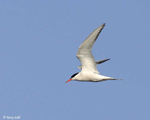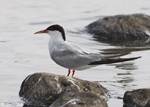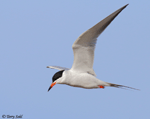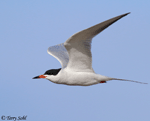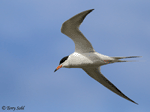| Length: 13 to 16 inches | Wingspan: 30 to 32 inches | Seasonality: Migrant / Summer |
| ID Keys: Long forked tail, black cap (breeding season), reddish slim bill, contrasting darker gray on upperside of wing-tip. | ||
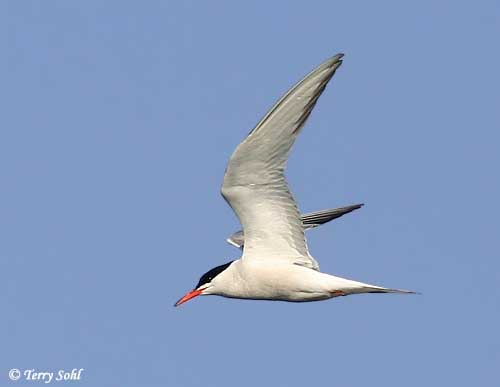 The Common Tern are
so-named because they are the most common tern in much of the Northeastern
U.S. In much of the inland portion of the continent, they are outnumbered
by the very similar Forster's Tern.
They were hunted to near extinction in the 1800s for their "fashionable"
feathers, but rebounded in the 1900s. As larger predatory gulls have
learned to co-exist with human populations and thrive on their refuse, the
Common Tern has once again suffered population declines from predation in
the latter half of the twentieth century.
The Common Tern are
so-named because they are the most common tern in much of the Northeastern
U.S. In much of the inland portion of the continent, they are outnumbered
by the very similar Forster's Tern.
They were hunted to near extinction in the 1800s for their "fashionable"
feathers, but rebounded in the 1900s. As larger predatory gulls have
learned to co-exist with human populations and thrive on their refuse, the
Common Tern has once again suffered population declines from predation in
the latter half of the twentieth century.
Habitat:
Can be found in a wide range of aquatic habitats during the summer breeding months, including coastal and inland waters. Primarily winters along coastlines in tropical regions of South America.
Diet:
Primarily feeds on small fish. Also will eat shrimp and other crustaceans, small mollusks, insects, marine worms, squid, and leeches.
Behavior:
Primarily feeds by hovering over water to spot prey, and then plunging below the surface to catch it. They are also accomplished thieves and will sometimes steal fish and other prey from other Common Terns or other gull and tern species.
Nesting:
June in South Dakota. Common Terns are colonial nesters, using areas near water with a surface of sand, gravel or small pebbles. The nest is a simple scrape on the ground, lined with vegetation, bits of shell or stone, or other material. The female lays between 1 and 3 eggs, and both she and the male help to incubate them. The young hatch from the nest after 21-25 days.
Song:
Vocal birds with a variety of calls. Click here to listen to the flight call of a Common Tern (audio courtesy of Jerome Fischer). They also have a harsh descending alarm call (click here to hear it, audio courtesy of Annette Hamann).
Migration:
Breeds in much of southern Canada and the northern tier of U.S. states. Most overwinter along the coast of South America, with only small numbers overwintering on the coasts of Central and North America.
Interactive eBird Map:
Click here to access an interactive eBird map of Common Tern sightings
Similar Species:
Conservation Status:
Numbers are much lower than historical levels due to hunting in the 1800s. Numbers rebounded in the first part of the 1900s, but the expansion in range and numbers of the large predatory gulls in the latter half of the century again caused reductions in their numbers. However, they are still found over a very broad geographic area, and they are common in parts of their range. The IUCN considers the Common Tern to be a species of "least concern".
Further Information:
1) Patuxent Bird Identification InfoCenter, Common Tern
3) Audubon Guide - Common Tern
Photo Information:
July 18th, 2004 -- Below Oahe Dam -- Terry Sohl
Additional Photos:
Click on the image chips or text links below for additional, higher-resolution Common Tern photos.
| Click on the map below for a higher-resolution view |
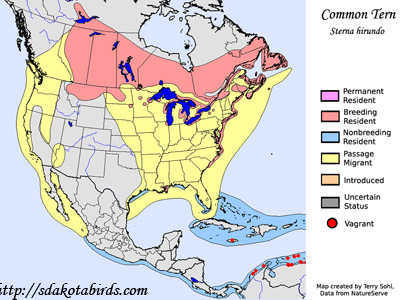 |
| South Dakota Status: Uncommon migrant in the east and along the Missouri River. Rare migrant in the western half of the state. Uncommon summer resident in the northeast. |
Additional Common Tern Photos
Click for a higher-resolution version of these photos
